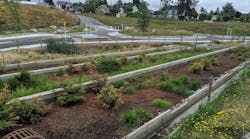Delivering the Stormwater Message
A few months ago, EPA and The Weather Channel teamed up to create a documentary called After the Storm, highlighting some causes and effects of water pollution – essentially describing nonpoint-source pollution and the dynamics of a watershed to a diverse audience. The program contained interviews with scientists and ordinary citizens, examples (from New York City, the Santa Monica Bay, and the Gulf of Mexico) of the damage polluted runoff can cause, and practical information on what people should do – marketing types would describe it as “the call to action” – to protect their own watersheds, such as recycling hazardous household waste and picking up after their dogs.A real need still exists for such information, notwithstanding the ongoing efforts of Phase II public-education and outreach efforts. All of us, at one time or another, have heard results of surveys conducted by water-quality outreach programs, in schools, or by a local news station doing a segment on water pollution. A recent survey in a southern California city, for instance, found that 68% of randomly selected people didn’t know what a watershed was, and, when asked whether they lived in a watershed, fewer than 28% said yes. Two Canadian surveys of people living along a particular stretch of polluted river concluded that public awareness is even declining a bit (in one survey, 27% of the people questioned defined “watershed” correctly; four years later, 23% did). The message is important, but the packaging is too, especially when that message is in danger of being lost in the surrounding noise. With so many causes and ideas competing for attention, a few well-produced documentaries and other tools that can be made available for use by many different stormwater programs seem to me a valuable complement to local efforts, which are almost without exception operating on limited budgets. The rights to After the Storm, for example, eventually will revert to EPA, which plans to make it available for broadcast by other television stations, as well as to educational organizations.
Repetition is critical to drive a concept home, whether you’re marketing a product or conveying an idea, and most local stormwater education programs just can’t deliver the variety or reach people as often as they need to. It’s taken years, but some powerful messages about once-obscure or -unpopular concepts have entered the public consciousness through long-repeated exposure. The general understanding of global warming and the shift in attitudes toward smoking are two of them, and arguably the entire environmental movement in the United States was born from the same sort of public awareness efforts in the 1960s and ’70s, leading not only to new legislation and increased private conservation efforts but also to easily recognized and understood milestones, including Earth Day.It’s true that many of the people who watch programs like After the Storm already have an interest in the subject and that those who neither know nor care what a watershed is are unlikely to seek them out. Then again, a widely distributed and often repeated program will draw in some chance viewers – perhaps some who, surfing television channels, will stumble across it, find it a preferable alternative to an infomercial, make a connection with something they’ve heard or seen locally, and learn something along the way.

